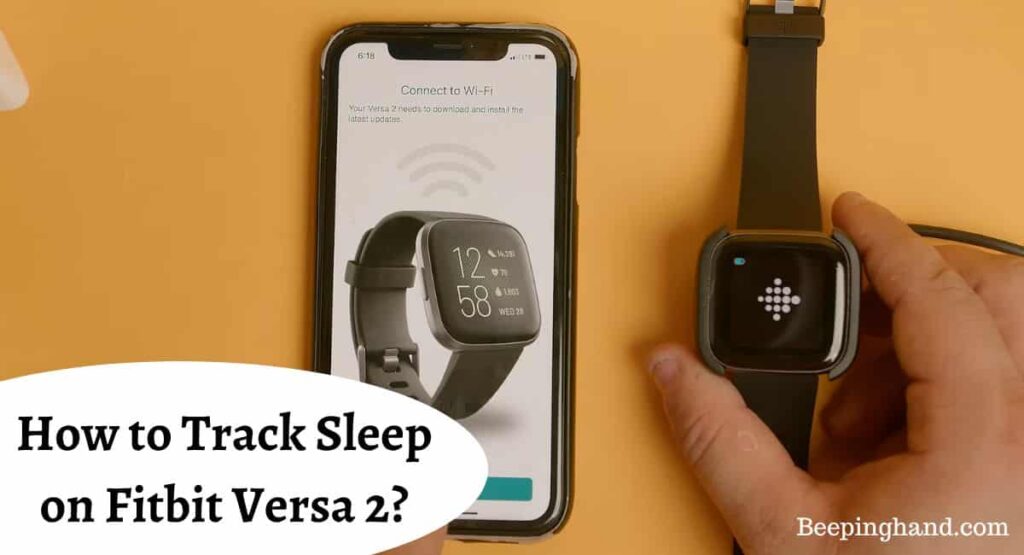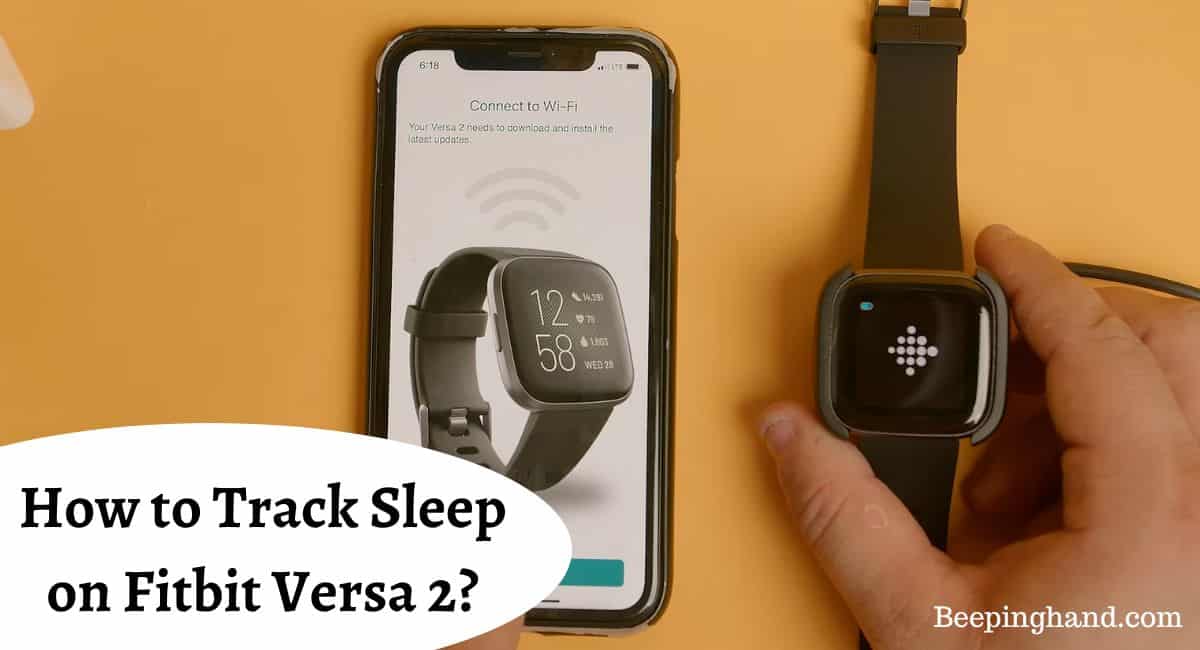If you’re looking to enhance your sleep tracking experience, the Fitbit Versa 2 is an excellent choice. Equipped with advanced sensors and intelligent algorithms, this smartwatch offers comprehensive sleep tracking features. By monitoring your sleep patterns and providing valuable insights, it helps you gain a better understanding of your sleep quality.
Here, we’ll walk you to the process of How to Track Sleep on Fitbit Versa 2, enabling you to optimize your sleep routine and improve your well-being.
How to Track Sleep on Fitbit Versa 2

The Fitbit Versa 2 is a popular smartwatch known for its advanced sleep-tracking capabilities. We’ll be discussing Tracking Sleep in this article.
Tips for Better Sleep Tracking Accuracy
To improve the accuracy and effectiveness of sleep tracking on your Fitbit Versa 2, consider the following tips:
- Wear the Device Properly – Ensure that you are wearing your Fitbit Versa 2 snugly and comfortably on your wrist while sleeping. A loose or ill-fitting device may affect the accuracy of sleep tracking.
- Keep the Device Charged – Charge your Fitbit Versa 2 regularly to ensure uninterrupted sleep tracking. A low battery may cause gaps in sleep data recording.
- Set a Consistent Bedtime Routine – Establish a regular sleep schedule by going to bed and waking up at the same time each day. Consistency in your sleep routine helps your Fitbit accurately detect sleep patterns.
- Create a Relaxing Sleep Environment – Prepare your bedroom for optimal sleep. Keep the room cool, dark, and quiet to promote better sleep quality.
- Avoid Stimulants Before Bed – Minimize or avoid the consumption of caffeine, nicotine, and alcohol before bedtime. These substances can interfere with your sleep patterns.
- Wind Down Before Sleep – Establish a pre-sleep routine that helps you relax and unwind. Engage in activities like reading a book, taking a warm bath, or practicing relaxation techniques to signal your body that it’s time to sleep.
- Optimize Your Bedroom for Sleep – Invest in a comfortable mattress, pillows, and bedding to create a sleep-friendly environment. Ensure that your sleeping surface supports your body and helps you maintain proper sleep posture.
- Limit Screen Time – Reduce exposure to electronic devices, such as smartphones and tablets, before bed. The blue light emitted by these devices can interfere with your sleep quality. Consider using a blue light filter or night mode on your devices.
- Keep a Sleep Diary – Track your sleep patterns manually by maintaining a sleep diary alongside your Fitbit sleep data. Note any factors that may affect your sleep quality, such as caffeine intake, stress levels, or sleep disturbances.
Also Read: Is Fitbit Versa 2 Waterproof
How to Track Sleep on Fitbit Versa 2
Here are the steps to track Sleep on Fitbit Versa 2 –
- Install the Fitbit App – Download and install the Fitbit app on your smartphone from the respective app store (Google Play Store for Android or App Store for iOS).
- Pair Your Fitbit Versa 2 – Open the Fitbit app and follow the on-screen instructions to pair your Fitbit Versa 2 with your smartphone via Bluetooth. Ensure that the device is fully charged before the pairing process.
- Enable Sleep Tracking – Once your Fitbit Versa 2 is paired, go to the Fitbit app and tap on the device icon in the top-left corner. Scroll down and tap on “Sleep” under “Tracking & Analysis.” Toggle the switch to enable sleep tracking on your device.
- Set Sleep Goals (Optional) – In the Fitbit app, you can set personalized sleep goals to help you achieve better sleep. Tap on “Sleep Goal” and adjust the desired hours of sleep per night.
- Wear Your Device to Bed – Wear your Fitbit Versa 2 comfortably on your wrist before going to bed. The device will automatically detect when you fall asleep and start tracking your sleep.
- Review Sleep Data – In the Fitbit app, you can view detailed sleep data, including sleep duration, sleep stages (light, deep, REM), and sleep quality. Tap on “Sleep” in the app’s dashboard to access the sleep log and insights.
Analyzing Sleep Data
Here are some tips for analyzing your sleep data effectively –
- Look at the total sleep duration recorded by your Fitbit. This gives you an idea of how much sleep you are getting on average. Compare it to the recommended amount of sleep for your age group to assess if you’re meeting the target.
- Sleep efficiency is the percentage of time you spend asleep compared to the total time spent in bed. A higher sleep efficiency indicates more restful sleep. If your sleep efficiency is consistently low, it may indicate poor sleep quality or disruptions during the night.
- Fitbit provides insights into different sleep stages, including light sleep, deep sleep, and REM sleep. Pay attention to the duration and distribution of these sleep stages. Adequate time spent in deep and REM sleep is crucial for restorative sleep.
- Look for patterns or trends in your sleep data over time. Note any changes in sleep duration, sleep quality, or sleep stages. This can help you identify factors that may affect your sleep, such as lifestyle choices, stress levels, or environmental conditions.
- Take into account external factors that may impact your sleep, such as caffeine intake, exercise, bedtime routines, or changes in medication. Cross-reference these factors with your sleep data to identify potential correlations or triggers.
- Fitbit assigns a sleep score based on various sleep metrics. Pay attention to your sleep score trends and aim to improve it over time. The sleep score provides an overall assessment of your sleep quality and can help you track your progress.
- Consider integrating your sleep data with other health metrics, such as activity levels, heart rate, or stress levels. Analyzing the relationship between sleep and these factors can provide a comprehensive understanding of your overall well-being.
- Based on your sleep data analysis, set realistic sleep goals to improve your sleep habits. This could include establishing a consistent bedtime routine, prioritizing sleep duration, or optimizing your sleep environment.
Wrapping Up
This article is all about How to Track Sleep on Fitbit Versa 2. Tracking your sleep on the Fitbit Versa 2 can provide valuable insights into your sleep patterns and help you make improvements for better sleep quality. By setting up sleep tracking, following best practices, and analyzing your sleep data, you can gain a deeper understanding of your sleep habits and make informed decisions to optimize your sleep.
I hope this article was helpful to you and if you still find any queries then you may ask in the comment box. For more information visit the Help and Support Page.
FAQ’s How to Track Sleep on Fitbit Versa 2
Can the Fitbit Versa 2 track sleep automatically?
Yes, the Fitbit Versa 2 can track sleep automatically once you have set it up in the Fitbit app. Simply wear your device while you sleep, and it will automatically detect and track your sleep patterns.
Can I track my sleep stages with the Fitbit Versa 2?
Yes, the Fitbit Versa 2 can track your sleep stages, including light, deep, and REM sleep. It uses various sensors and algorithms to analyze your movement and heart rate during sleep and provides detailed insights into your sleep stages.
How accurate is the sleep tracking on the Fitbit Versa 2?
Fitbit devices, including the Versa 2, are known for their reliable sleep tracking capabilities. While no tracking method is 100% accurate, Fitbit uses advanced algorithms and multiple sensors to provide accurate sleep data.
Can I view my sleep data on the Fitbit Versa 2?
Yes, you can view your sleep data directly on the Fitbit Versa 2 by swiping up on the clock face and selecting the sleep tile. You can also access more detailed sleep insights and trends in the Fitbit app on your smartphone.
Does the Fitbit Versa 2 track naps?
Yes, the Fitbit Versa 2 can track daytime naps as well. Simply wear your device while you nap, and it will automatically detect and record the duration and quality of your nap.
How can I improve the accuracy of sleep tracking on my Fitbit Versa 2?
To improve the accuracy of sleep tracking, make sure you wear your Fitbit Versa 2 snugly on your wrist, set your preferred sleep goal and bedtime reminders in the Fitbit app, and ensure your device’s battery is adequately charged before going to bed.
Can I use the Fitbit Versa 2 to track my partner’s sleep as well?
The Fitbit Versa 2 is designed to track the sleep of the wearer. If you want to track your partner’s sleep, they would need to wear their own Fitbit device or use a separate sleep tracking solution.
How long does the battery of the Fitbit Versa 2 last during sleep tracking?
The Fitbit Versa 2 has a battery life of up to 6 days, depending on usage. With sleep tracking enabled, the battery can typically last for multiple nights of sleep tracking before needing to be recharged.
Can I track my sleep without a smartphone using the Fitbit Versa 2?
Yes, the Fitbit Versa 2 can track your sleep without a smartphone. It stores the sleep data internally, and you can sync it with the Fitbit app on your smartphone when you have access to it.
Does the Fitbit Versa 2 have a silent alarm for waking up?
Yes, the Fitbit Versa 2 has a silent alarm feature that uses gentle vibrations to wake you up without disturbing your partner. You can set alarms directly on the device or through the Fitbit app.
